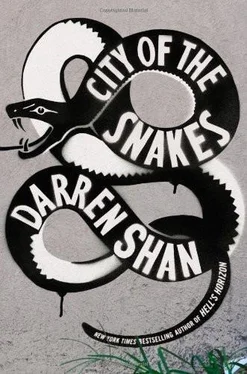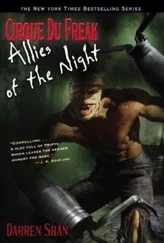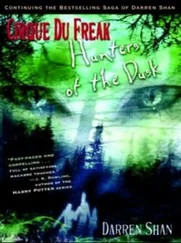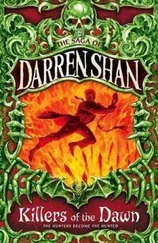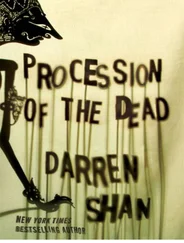Darren Shan - City of the Snakes
Здесь есть возможность читать онлайн «Darren Shan - City of the Snakes» весь текст электронной книги совершенно бесплатно (целиком полную версию без сокращений). В некоторых случаях можно слушать аудио, скачать через торрент в формате fb2 и присутствует краткое содержание. Год выпуска: 2011, ISBN: 2011, Жанр: Ужасы и Мистика, на английском языке. Описание произведения, (предисловие) а так же отзывы посетителей доступны на портале библиотеки ЛибКат.
- Название:City of the Snakes
- Автор:
- Жанр:
- Год:2011
- ISBN:978-0-446-58546-0
- Рейтинг книги:3 / 5. Голосов: 1
-
Избранное:Добавить в избранное
- Отзывы:
-
Ваша оценка:
- 60
- 1
- 2
- 3
- 4
- 5
City of the Snakes: краткое содержание, описание и аннотация
Предлагаем к чтению аннотацию, описание, краткое содержание или предисловие (зависит от того, что написал сам автор книги «City of the Snakes»). Если вы не нашли необходимую информацию о книге — напишите в комментариях, мы постараемся отыскать её.
City of the Snakes — читать онлайн бесплатно полную книгу (весь текст) целиком
Ниже представлен текст книги, разбитый по страницам. Система сохранения места последней прочитанной страницы, позволяет с удобством читать онлайн бесплатно книгу «City of the Snakes», без необходимости каждый раз заново искать на чём Вы остановились. Поставьте закладку, и сможете в любой момент перейти на страницу, на которой закончили чтение.
Интервал:
Закладка:
“Capac!” Ama reacts instantly, rushing to his side.
“It would be easier to kill him,” the priest says. “That way he can re-form on the train, physically whole. Otherwise he faces a slow, painful recovery.”
“Later,” I say. “He’s got a right to the answers too. Give us a few minutes to clean his wounds.”
The priest looks to his queen, who shrugs lazily. “Very well. But be quick. I wish to take word of this momentous occasion to my brothers. We have waited so long for the bloodlines to merge. There will be much celebrating tonight.”
“We’ll do the best we can,” I lie blithely, and step aside to let Ama tend to her lover’s wounds. She works slowly, wiping away blood with her robes, fetching water from a barrel near the foot of the bed. There’s not much she can do about his nose and ears, but she fusses over the gaps, stretching out the minutes, as aware as I am of the need to procrastinate.
“We need to stitch these,” Ama says, examining gashes on his skull and chest.
“That won’t be necessary,” the priest replies. “We have wasted enough time.”
“But it will only take—”
“No,” he snaps. “Our Coya is tiring of your company. Put your questions to her now or take them with you.”
I can’t think of an excuse to delay further, so I settle into my role of inquisitor. “Let’s start with the Ayuamarcans. As I understand it, Ferdinand Dorak created them with your assistance, and when he died, they died as well. So how come this lot”—I wave at my back-from-the-dead companions—“are up and walking?”
The Coya answers slowly, the priest translating as she speaks.
“There was much Ferdinand Dorak didn’t know about our powers. He saw what we wished him to see, no more. Where there were gaps, he overlooked them or filled them in with logic of his own. We never corrected him when he was wrong. We never even spoke to him in words he could comprehend — we had not bothered at that time to learn the language of your people.
“The generation of the Ayuamarcans was not as straightforward as he believed. When he wished to create a person, he chose a face from his dreams, then came to our villacs . Having shared his dream, they had constructed a doll in advance, which they daubed with their blood and his, then cast a spell on. He thought that was the end of the process.”
The Coya shakes her head and chuckles. “It was not so simple. Every act of creation requires a mother and a father. That was why Viracocha split himself in two when he wished to create the first humans. As a single entity he could only replicate himself. Divided, he was able to give life to new creatures, to Inti Maimi and Mama Ocllo.”
“Wait a minute,” I interrupt. “You’re not trying to tell us that thing on the bed is the same Mama Ocllo of your legends, are you?”
“No,” the priest answers directly, “but she is a direct descendant. Each of our Coyas lives for more than a hundred years, giving birth to thirty or more children. When her body withers, her spirit finds a home in one of her children and lives again, carrying on with only the briefest of interruptions.”
“These children,” Paucar Wami says to the queen, then stops and addresses his question to me. “Do they breed with one another, or with outside stock?”
“The villacs and mamaconas are of pure blood,” the priest replies huffily. “Our Incan followers — those who helped escort us here — bred with the Indians who were indigenous to this region, and later with the Europeans, but we have always remained apart.”
“That explains a lot,” Wami murmurs. “The pale skin, the thin hair, the various genetic oddities.”
“Don’t mock us,” the priest growls. “We are not cursed with the weaknesses of inbreeding. Our people long ago discovered ways to combat such defects. We are as strong of constitution as any race.”
“Let’s get back to the creating business,” Raimi mutters. “I want to know what they held back from Dorak.”
The Coya recommences. “Creation requires a man and a woman. Our Watanas have traditionally served the function of the father. Our priests could have adopted that role, but we chose to include members of the communities which we ruled, partly to strengthen the ties between us, mostly to prevent internal conflict — a villac who possessed the powers of a Watana would have been a threat.
“Ferdinand Dorak was the last Watana . With your creation”—she points to Raimi—“we abandoned the practice. This world has changed faster than our forefathers ever imagined. We needed a new breed of representative to face it. Thus we had our Watana create an immortal being, one with the power of—”
“We know this part,” Raimi snarls. “Get back to how we were created and how you reanimated Ama and Paucar Wami.”
The priest glares at Raimi, then looks to his queen. She ponders the request, then nods. Walking to one of the hanging sheets, he parts the folds and calls to the mamaconas . There’s a scuffling sound, then two naked priestesses enter with wooden trays, upon which lie a number of dolls. They lay the trays on the bed, bow low to the Coya and depart.
We study the dolls in silence. A doll of my father is there, and one of Ama. There are others I recognize — Conchita Kubekik and Inti Maimi.
“Leonora Shankar,” Wami murmurs, pointing to the doll of the once-famous restaurateur.
“And Adrian Arne,” Raimi adds, reaching for the doll of a young man, stopping before he touches it, slowly withdrawing his hand. He glances at the Coya but speaks to me. “Ask her if these have been stolen from Party Central.”
“No,” comes the answer. “What Dorak didn’t know was that there were two of each doll. There had to be, just as you need a sperm and an egg to make a baby. The blood he gave to his doll was combined with the blood our Coya gave to hers, and the pair were used to produce the Ayuamarcans.”
The Coya picks up a doll — Ama’s — and runs a cracked nail over the top of its head. Ama shivers violently, then steels herself and stares impassively at the queen of the underworld Incas.
“When Dorak destroyed a doll by piercing its heart,” the Coya continues, “he eliminated its body but not its spirit. For that to happen, the other doll’s heartbeat also needed to be stopped. Until it was, the spirit of the dream person remained at our disposal, to be recalled any time we wish.”
I frown. “But you said a male and female were needed. If Dorak was the last of the Watanas , how can you bring the Ayuamarcans back to life?”
“Restoring life is not the same as creating it,” the Coya says. “We cannot create new beings without the Watana , but we can restore the essence of those who have walked before. Thus we brought back Paucar Wami when we needed a figurehead to front the Snakes. And Ama Situwa when we needed to lure Capac Raimi to us.”
“Care to tell us how you pull that trick off?” Raimi asks sourly.
“Good magicians never reveal their secrets,” the priest chuckles without asking his queen. “And we are the very best magicians.”
“It makes sense,” Raimi mutters, “in its own crazy way. It explains why Dorak always had to wait a day or so for his Ayuamarcans to appear — the Coya had to weave her magic over the other doll. And it accounts for you being here”—this to Ama and Wami—“in your original forms. Your dolls never aged, and since they used those to restore you, you look the same the second or twentieth time around.”
“Couldn’t they have had one doll instead of two?” Ama asks. “I understand that both the blood of the Watana and Coya were needed, but I don’t see the need for the duplicate dolls.”
Читать дальшеИнтервал:
Закладка:
Похожие книги на «City of the Snakes»
Представляем Вашему вниманию похожие книги на «City of the Snakes» списком для выбора. Мы отобрали схожую по названию и смыслу литературу в надежде предоставить читателям больше вариантов отыскать новые, интересные, ещё непрочитанные произведения.
Обсуждение, отзывы о книге «City of the Snakes» и просто собственные мнения читателей. Оставьте ваши комментарии, напишите, что Вы думаете о произведении, его смысле или главных героях. Укажите что конкретно понравилось, а что нет, и почему Вы так считаете.
